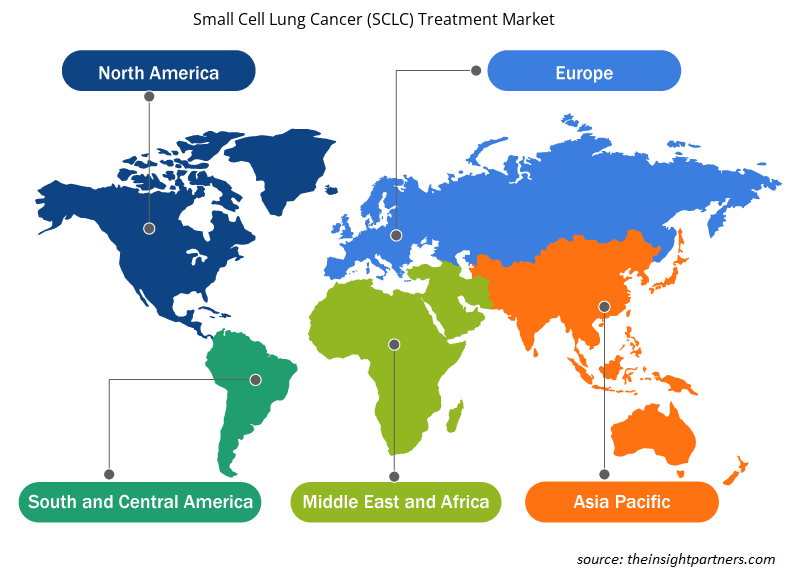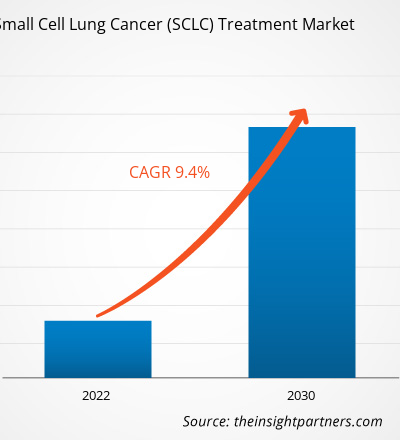[研究报告] 小细胞肺癌治疗市场规模预计将从2022年的44.8085亿美元增长到2030年的91.7360亿美元;预计2022年至2030年市场复合年增长率为9.4%。
小细胞肺癌的发病率不断上升,以及小细胞肺癌治疗市场中治疗方法和联合疗法的可用性是推动小细胞肺癌治疗市场增长的值得注意的因素。产品发布和快速的产品审批也是在 2020-2030 年提供丰厚市场机会的关键因素。
小细胞肺癌 (SCLC) 是一种侵袭性肺癌,其特征是肺部某些细胞快速且不受控制地生长。SCLC 的主要风险因素是吸烟和吸食烟草,其症状因人而异。SCLC 分为几个主要阶段,例如局限期疾病和广泛期疾病。SCLC 患者通常接受化疗和放射治疗,对于早期癌症,可能建议进行手术。
增长动力:
小细胞肺癌患病率上升及治疗手段可用性
根据 Genentech, Inc. 2023 年报告,SCLC 约占所有难治性肺癌病例的 13%。因此,SCLC 是最具侵袭性的肺癌类型,5 年生存率极低。目前 SCLC 的治疗选择有限,需要新的有效治疗方法来提高生存率。例如,一线铂类化疗 (CT) 是推荐用于治疗的主要方法。此外,联合化疗药物如“顺铂”和“卡铂”是与“依托泊苷”联合用于治疗 SCLC 的最推荐药物。
美国国家癌症研究所的报告显示,小细胞肺癌占支气管癌的近 15%。然而,由于患者对放化疗反应良好,美国小细胞肺癌的总体发病率在过去几十年中有所下降。例如,胸部放射治疗也改善了患者的长期医疗保健结果。因此,小细胞肺癌在人群中的患病率上升以及治疗特定疗法的可用性是 2020-2030 年预测期内全球小细胞肺癌市场大幅增长的关键因素。
定制此报告以满足您的需求
您可以免费定制任何报告,包括本报告的部分内容、国家级分析、Excel 数据包,以及为初创企业和大学提供优惠和折扣
-
获取此报告的关键市场趋势。这个免费样品将包括数据分析,从市场趋势到估计和预测。
小细胞肺癌(SCLC)联合治疗市场
肺癌联合治疗是肺癌研究的最新进展,临床研究表明,成功治疗的患者可提高小细胞肺癌患者的总体生存率。化疗药物与免疫疗法联合使用就是针对小细胞肺癌的联合治疗的一个例子。Atezolizumab (Tecentriq) 是 FDA 批准的治疗小细胞肺癌的药物,与“卡铂和依托泊苷”联合使用,作为广泛期小细胞肺癌成人患者的一线治疗。同样,临床研究人员已经确定两种药物的组合可以降低小细胞肺癌患者的死亡率,小细胞肺癌是肺癌中最具侵袭性的类型。大多数患者对通过化疗免疫疗法将小细胞肺癌作为一线治疗有积极反应,但癌症复发的可能性很高。因此,联合治疗,如化疗药物“拓扑替康 (Hycamtin)”和研究药物“Berzosertib”,负责抑制一种有助于修复小细胞肺癌造成的 DNA 损伤的蛋白质。因此,预计上述因素将有利于 2020-2030 年期间的市场增长。
市场机会
产品发布和快速产品审批
大多数 SCLC 患者对化疗和免疫疗法的初始治疗有反应。然而,尽管进行了额外的治疗,癌症通常仍会进展,大多数患者会在数周或数月内死亡。因此,快速的产品批准很可能为市场在 2020 年至 2030 年期间呈指数级增长提供有利可图的机会。例如,2020 年 3 月,美国食品药品监督管理局 (FDA) 宣布批准“Durvalumab”与“Etoposide”和“Carboplatin”或“Cisplastin”的组合作为广泛期 SCLC 患者的一线治疗。此外,2019 年 3 月,美国食品药品监督管理局批准“Tecentriq”用于治疗 SCLC。新批准的“Tecentriq”是第二种获批用于晚期 SCLC 患者的免疫治疗药物,也是一线治疗药物。
未来趋势
CAR-T 细胞疗法提供新的治疗选择
治疗 SCLC 的新研究方法在未来几年可能会显示出巨大的前景。CAR -T 细胞疗法 就是一个例子,它在临床前研究中显示出对 SCLC 的巨大前景。CAR T 细胞疗法是一种“活体药物”,负责显示药理活性,例如重新设计患者的 T 细胞,使其能够附着在癌细胞上并摧毁它们。Delta 样配体 3 (DLL3) 是一种在 SCLC 肿瘤细胞表面发现的抗原,包括肺癌、前列腺癌、乳腺癌、胰腺癌和肠道高级别癌症,因此,针对 DDL3 的 CAR T 细胞疗法可以为这些疾病提供新的治疗选择。因此,CAR T 细胞疗法的进步将在不久的将来成为一种新的市场趋势,最终推动 2020-2030 年的市场增长。
报告细分和范围:
全球 SCLC 治疗市场分为治疗、阶段和最终用户。根据治疗方法,市场分为化疗、放射疗法、免疫疗法和其他。就分期而言,SCLC 治疗市场分为广泛期和有限期。根据最终用户,SCLC 治疗市场分为医院、专科诊所、家庭护理环境和其他。根据地理位置,SCLC 治疗市场分为北美(美国、加拿大和墨西哥)、欧洲(德国、法国、意大利、英国、西班牙和欧洲其他地区)、亚太地区(澳大利亚、中国、日本、印度、韩国和亚太其他地区)、中东和非洲(南非、沙特阿拉伯、阿联酋和中东和非洲其他地区)以及南美洲和中美洲(巴西、阿根廷和南美洲和中美洲其他地区)。
节段分析:
根据治疗方法,SCLC 治疗市场细分为化疗、放射疗法、免疫疗法等。2022 年,化疗领域占据了最大的市场份额。小细胞肺癌最初往往对化疗反应良好。SCLC 的化疗药物通常通过静脉输注给药。SCLC 最常见的两种化疗药物包括“依托泊苷加顺铂”和“依托泊苷加卡铂”。此外,“拓扑替康和鲁比奈克定”是 SCLC 患者可以服用的化疗药物。因此,预计在 2020-2030 年期间,化疗药物与 SCLC 治疗相结合的可用性将影响该领域的市场。
根据分期,SCLC 治疗市场分为广泛期和有限期。2022 年,广泛期细分市场占据了最大的市场份额。预计同一细分市场将在 2022-2030 年期间实现最高的复合年增长率。广泛期 SCLC 广泛扩散至肺部、淋巴结、胸部和其他身体部位(包括骨髓)。根据美国癌症协会 2023 年的报告,大约 3 分之 2 的 SCLC 患者患有广泛性疾病,癌症首次被发现。因此,随着疾病广泛期的上升,化疗是更好地控制癌症的一线治疗选择。
根据最终用户,SCLC 治疗市场细分为医院、专科诊所、家庭护理环境等。2022 年,医院部门占据了最大的市场份额。然而,专科诊所部门预计将在 2022-2030 年期间实现最快的复合年增长率。SCLC 治疗主要在医院进行,由肺病学家、肿瘤内科医生、放射肿瘤学家和胸外科医生组成的团队密切合作,为 SCLC 制定个性化治疗计划。治疗计划包括化疗、放射治疗和手术。此外,医院还为 SCLC 和各种医疗状况提供多学科治疗。此外,还提供各种支持服务,以改善患者的生活质量和全面而富有同情心的护理。这些综合服务包括肺康复、戒烟、心理和社会支持以及综合疗法。纽约大学朗格尼医院就是 SCLC 疗法的一个例子。因此,医院提供的定制治疗计划和支持服务是预计在 2020-2030 年期间影响市场增长的主要因素。
区域分析:
根据地理位置,SCLC 治疗市场分为五个主要区域:北美、欧洲、亚太地区、南美和中美以及中东和非洲。北美市场分析主要集中在三个主要国家——美国、加拿大和墨西哥。2022 年,美国占据 SCLC 治疗市场的最大份额。根据耶鲁医学 2023 年报告,SCLC 占美国每年所有肺癌诊断的 15%。因此,仅在美国,随着 SCLC 病例的增加,对 SCLC 药物的需求就很高,以降低美国的死亡率。同样,治疗 SCLC 的药物的快速产品批准预计将进一步促进 2022-2030 年期间的市场增长。例如,2020 年 6 月,Jazz Pharmaceuticals plc 宣布美国食品药品监督管理局批准“Zepzelcaa”用于治疗接受铂类化疗期间或之后病情进展的转移性 SCLC 成年患者。“Zepzelcaa”现已在美国上市,并将推动 2020 年至 2030 年的市场增长。
同样,亚太地区将在 2022-2030 年期间实现 SCLC 治疗市场的最高复合年增长率。在亚太地区,中国在 2020-2030 年期间占据 SCLC 治疗市场的大部分份额。中国 SCLC 治疗产品的快速批准是 2022-2030 年市场增长的主要因素。据记录,2021 年 7 月,阿斯利康宣布在中国批准“Imfinzi (durvalumab)”作为所有广泛期 SCLC 成年患者的一线治疗。中国国家药品监督管理局的批准是基于 CASPIAN III 期试验的积极结果,临床试验显示,“Imfinzi plus”化疗与单独化疗相比,在患者生存率方面表现出统计学上显着且具有临床意义的改善。作为广泛开发计划的一部分,ADRIATIC III 期试验中还对局限期 SCLC 患者在同步放化疗治疗后进行了“Imfinzi Plus”测试。因此,预计上述因素将在 2020-2030 年期间影响亚太地区的 SCLC 治疗市场。
小细胞肺癌 (SCLC) 治疗市场区域洞察
Insight Partners 的分析师已详尽解释了预测期内影响小细胞肺癌 (SCLC) 治疗市场的区域趋势和因素。本节还讨论了北美、欧洲、亚太地区、中东和非洲以及南美和中美洲的小细胞肺癌 (SCLC) 治疗市场细分和地理位置。

- 获取小细胞肺癌 (SCLC) 治疗市场的区域特定数据
小细胞肺癌(SCLC)治疗市场报告范围
| 报告属性 | 细节 |
|---|---|
| 2022 年市场规模 | 44.8085亿美元 |
| 2030 年市场规模 | 91.736 亿美元 |
| 全球复合年增长率(2022 - 2030 年) | 9.4% |
| 史料 | 2020-2022 |
| 预测期 | 2022-2030 |
| 涵盖的领域 |
按治疗
|
| 覆盖地区和国家 |
北美
|
| 市场领导者和主要公司简介 |
|
市场参与者密度:了解其对商业动态的影响
小细胞肺癌 (SCLC) 治疗市场正在快速增长,这得益于终端用户需求的不断增长,而这些需求又源于消费者偏好的不断变化、技术进步以及对产品优势的认识不断提高等因素。随着需求的增加,企业正在扩大其产品范围,进行创新以满足消费者的需求,并利用新兴趋势,从而进一步推动市场增长。
市场参与者密度是指在特定市场或行业内运营的企业或公司的分布情况。它表明在给定市场空间中,相对于其规模或总市场价值,有多少竞争对手(市场参与者)存在。
在小细胞肺癌 (SCLC) 治疗市场运营的主要公司有:
- F. 霍夫曼-拉罗什
- 百时美施贵宝
- 阿斯利康
- 爵士制药公司
- 默克集团
免责声明:上面列出的公司没有按照任何特定顺序排列。

- 了解小细胞肺癌 (SCLC) 治疗市场顶级关键参与者概况
竞争格局和重点公司:
F. Hoffmann-La Roche、百时美施贵宝、阿斯利康、Jazz Pharmaceuticals plc、默克集团、雷迪博士实验室、葛兰素史克 (GSK)、辉瑞、再生元和杨森是全球 SCLC 治疗市场上几家著名的 SCLC 治疗制造商。这些公司专注于新技术、现有产品的进步和地域扩张,以满足全球日益增长的消费者需求,并扩大其专业产品组合的产品范围。2022 年 11 月,再生元制药公司宣布美国食品药品监督管理局批准其“PD-1 抑制剂”Libtayo (cemiplimab-rwlc)”与铂类化疗联合使用,用于成人患者的一线治疗。Libtayo 还被批准用于延长晚期 SCLC 患者的生存期。
- 历史分析(2 年)、基准年、预测(7 年)及复合年增长率
- PEST和SWOT分析
- 市场规模、价值/数量 - 全球、区域、国家
- 行业和竞争格局
- Excel 数据集
近期报告
客户评价
购买理由
- 明智的决策
- 了解市场动态
- 竞争分析
- 客户洞察
- 市场预测
- 风险规避
- 战略规划
- 投资论证
- 识别新兴市场
- 优化营销策略
- 提升运营效率
- 顺应监管趋势























 获取免费样品 - 小细胞肺癌(SCLC)治疗市场
获取免费样品 - 小细胞肺癌(SCLC)治疗市场